Violet "YAN-Minuet": characteristics and care

Of all the variety of indoor plants, the most popular flower in our country, the violet YAN-Minuet, attracts attention and arouses admiration, which amazes with its delightful beauty. Having a beautiful appearance, it enchants with the finest aroma and spreads the fragrance throughout the entire room.

History of the genus and variety
For the first time a flower with the name "Saintpaulia violet" appeared in Ghent at an international exhibition in 1983. The German botanist Wendland gave the name to the species and allocated this plant to the genus, who, by selection from the seeds of a wild flower, created an indoor masterpiece popular all over the world.
Since then, this genus of herbaceous plants with rosettes of flowers belonging to the Gesneriaceae family has received the general name "saintpaulia" or "umbar violet", after the place of its initial discovery in Tanzania, and in common parlance - "violet".
In fact, the flowers of Saintpaulia and violet, although outwardly similar, belong to different families: Gesneriaceae and violet, respectively, these are two genera distant from each other according to the classification. However, in sources, literature and everyday life, it is customary to combine these names and use "violet" instead of "saintpaulia".

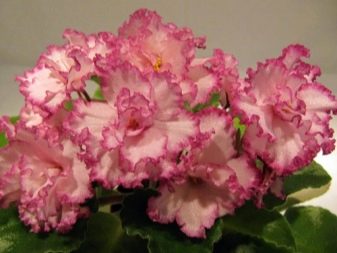
Features and differences from others
Violet Saintpaulias are perennial, undersized plants. They have a relatively short stem, surrounded by beautiful leaves with different shades of green.
According to the shape of flowers, saintpaulias are subdivided into groups: classic, starry, notched, fantasy. According to the type of leaf, there are boy (pure green) and girlish (with a light spot at the base). In terms of the diameter of the rosette, there are giants with a size of up to 40 cm, miniature - up to 15 cm - or completely microminiature (about 6 cm).
For the violet YAN-Minuet, it will not be difficult to make a description of the variety, since it is easy to distinguish it from others by the shape of the leaf and the color of its corrugated, double inflorescences.


The unique variety symbolizes the spring rebirth of nature, its flowering begins in early March and lasts 10 months, until the arrival of winter. Unusual, with an outlandish palette, they release delicate buds of five petals and two stamens. They grow in rosettes, forming airy bouquets, which are an adornment of window sills of any interior style.
Pale pink petals with crimson edging are a distinctive feature of the variety. It strikes with an almost watercolor tone, a smooth transition. Large voluminous stellate inflorescences with a contrasting border can reach up to 9 cm in diameter. Each branch has three openwork buds.
Pointed leaves of a bright emerald tone with a velvety surface covered with small villi, in the shape of a heart. Saintpaulia fruits are elongated seed pods.

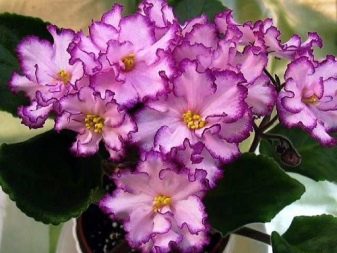
Growing and care conditions
In order for the plant to have a beautiful and rich flowering, it is necessary to take care of the lighting in the room, the temperature regime, and the level of humidity.
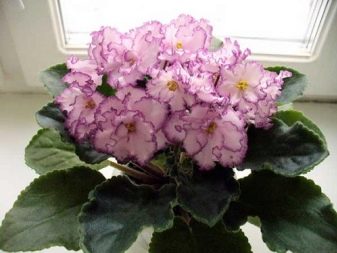
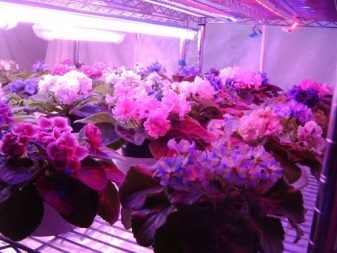
Growing violets requires attention and adherence to the algorithm for caring for and organizing climatic conditions.
- The violet is a light-loving creature, therefore, young seedlings, only germinated from the leaves, are immediately placed on the windowsill so that the rosette is formed correctly when exposed to sunlight, but the direct rays of the sun can be detrimental to the delicate leaves and petals of this violet and leave burns on them.
- It is helpful to rotate the planter with plants for even light and balanced growth.
- On a profusely overgrown outlet, the lower row of the crown is cut off, dried and diseased leaves are removed.
- It is undesirable to grow on shelves where there is no direct uniform light hit, flowers may not develop correctly.
- In winter, small decorative coasters are installed to protect the roots of the violet from the cold.
- Properly prepared soil will provide the plant with trace elements and nutrients.
- It is better to purchase soil suitable for violets in a specialized gardening store. It will take into account all the proportions of the necessary substances and balance the composition of the mixture: forest turf, sand, peat. This will make the earth lightweight, capable of allowing food and moisture to pass to the roots.
- Before planting, a drainage mat, which can also be bought at the store, is poured onto the bottom by one third.
- Choose a plastic pots, large in diameter, but shallow and always with a pallet.
- The pot must be new, on the walls of the old, already used ones, deposits from salts accumulate, which has a bad effect on the growth of the plant.
- Violets covered with dust can be washed by spraying, but it is advisable to put them on the windowsill only when the leaves are completely dry, otherwise they will become covered with spots.

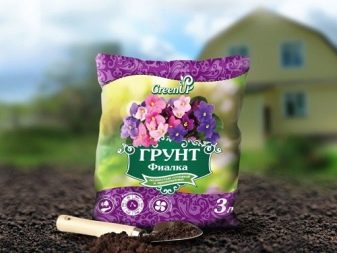
Compliance with the temperature and humidity regime
In a hot room with a high air temperature, with insufficient watering and illumination, violets develop poorly, the inflorescences are stretched.
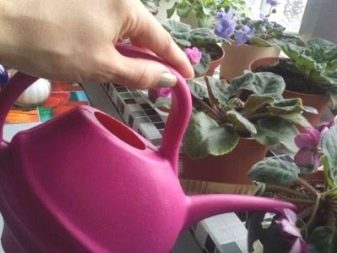

Regular correct irrigation has a beneficial effect on the leaves of the plant, they become saturated, green.
- Room temperature, maintain from +20 to +24, do not allow drops. This will slow down the growth of the plant, and with a decrease in degrees, it will lead to its death.
- When airing, strong drafts should not be allowed; it is better to remove the violet from the window for a while.
- Direct sunlight in summer can cause leaf burns.
- Controlling air humidity is essential. Violet Jan Minuet is a moisture-loving plant that responds well to maintaining humidity within 60–70%. When the atmosphere is very dry, the leaves wither and dry out.
- The presence of a hydrometer helps to monitor the humidity of the air and, if the indicators deteriorate, do additional irrigation with special devices or spray water with a spray bottle.
- When watering and spraying, they monitor so that moisture does not get on the crown of the plant. The liquid is introduced through the sump, the water should be at room temperature and settled for at least two days. Do not allow the soil to dry out.
- In summer, watering is carried out in small portions 3 times a week, providing constant humidity. In winter - much less often, when the soil dries out in the pots.
- When the plant dries up, as evidenced by drooping leaves, resuscitation measures are taken. To do this, immerse a pot of violets in a bowl of warm water. Cover the entire structure with polyethylene to create a microclimate. The rhizomes are moistened and the plant gradually revives.
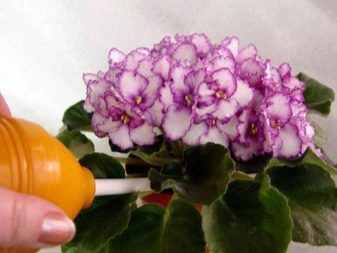
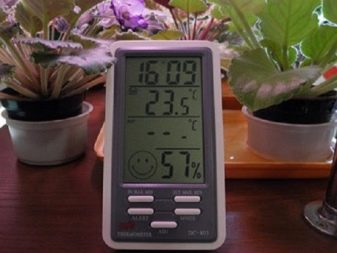
Planting and breeding rules
Saintpaulias are bred in three ways: cuttings, peduncles and leaves. The transplant is carried out in early spring. Foliage propagation is more efficient and is preferred by many. Healthy, without visible damage, seedling material cut from the outlet at an acute angle is placed in a jar of warm water, and placed in a warm place. Activated carbon is added to soften the water. When roots up to 1 cm appear, the sprout is transplanted into a pots with prepared soil.
If it is necessary to transplant an adult plant, it is taken out of the old container carefully, without damaging the root system. They are transferred to a new prepared pot along with a lump of earth and poured with a fertile mixture to the level of the outlet.
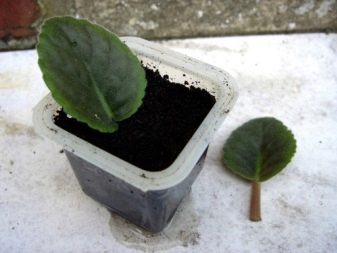
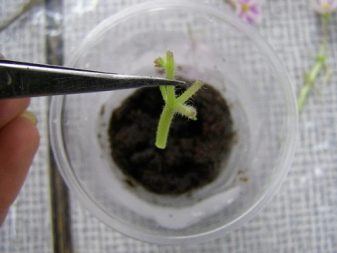
How to feed and fertilize?
Violet YAN-Minuet is responsive to feeding. They use complex mineral fertilizers specially selected for Saintpaulia. They are brought in once every two months, which prevents a number of diseases. The composition should include nitrogen - for the active development of the leaf rosette - and phosphorus (for abundant regular flowering).
With an insufficient amount of potassium, edging appears on the crown.
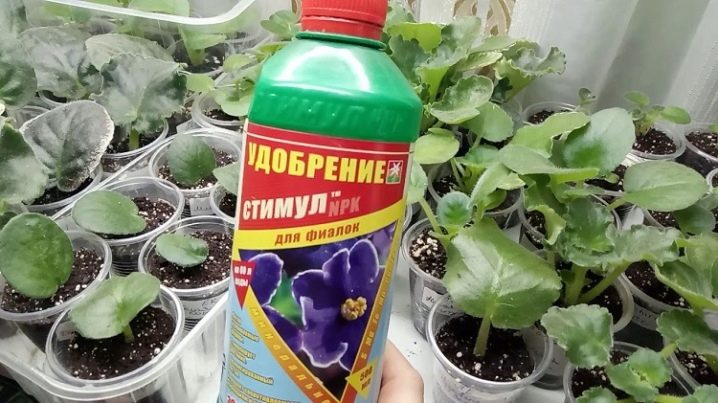
Disease and pest control
Violets, like many other plants, are susceptible to diseases such as late blight, powdery mildew, gray rot, white rot. Most often, a white plaque appears, which is disposed of by spraying with a solution that kills bacteria and microbes. It is worse when the roots are damaged and brown spots appear on the leaves - you need to get rid of such plants. When red tones and rot are found on the crown, a one percent solution of potassium permanganate helps well.
Parasites such as ticks, whiteflies, worms, and nematodes cause great harm. When cobwebs, traces of eating, sticky drops and other anomalies are found, the plant is urgently treated with complex pest control substances.
When attacked by nematodes, when the bush begins to rot, it is destroyed.
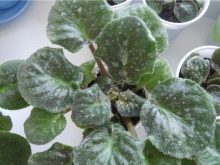

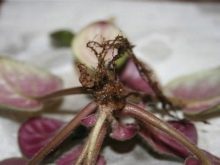
Signs of improper care
The most common problems in growing Saintpaulia are caused by insufficient light control. air temperature, watering and improper feeding:
- lack of flowering means that there is not enough light, a lot of nitrogen, excess or lack of moisture;
- the soil is compacted and does not allow air to reach the roots;
- yellowed leaves speak of the aging of the bush;
- the crown loses color, dry spots form in direct sunlight;
- soil acidity is higher than normal.
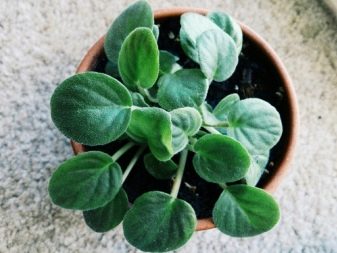
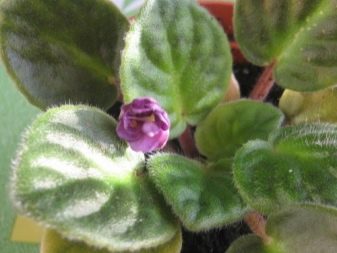
Reviews
In the majority of positive reviews, lovers of growing indoor plants share their enthusiastic impressions of the beauty and extraordinary colors with the edging of the violet YAN-Minuet. The combination of its emerald, heart-shaped leaves with a lush cloud of pale pink inflorescences with crimson edging is noted.
A disadvantage in some reviews is the ability of the plant to stretch its leaves upward due to the lack of normal lighting and cool moist air. It is believed that caring for a violet is troublesome, and the plant is capricious.
Breeders claim that violet Saintpaulia YAN-Minuet has energy that can calm, relieve stress and irritation.
With their beauty and fragrance, they influence the atmosphere of hospitality and comfort in the house.

You can watch an overview of the Jan-Minuet violets in the video below.































The comment was sent successfully.